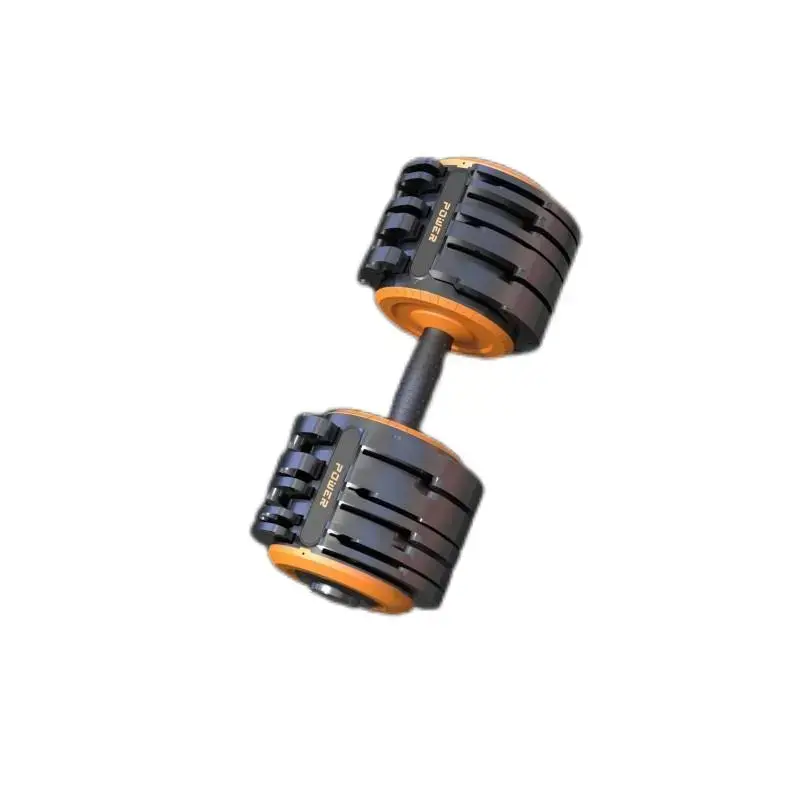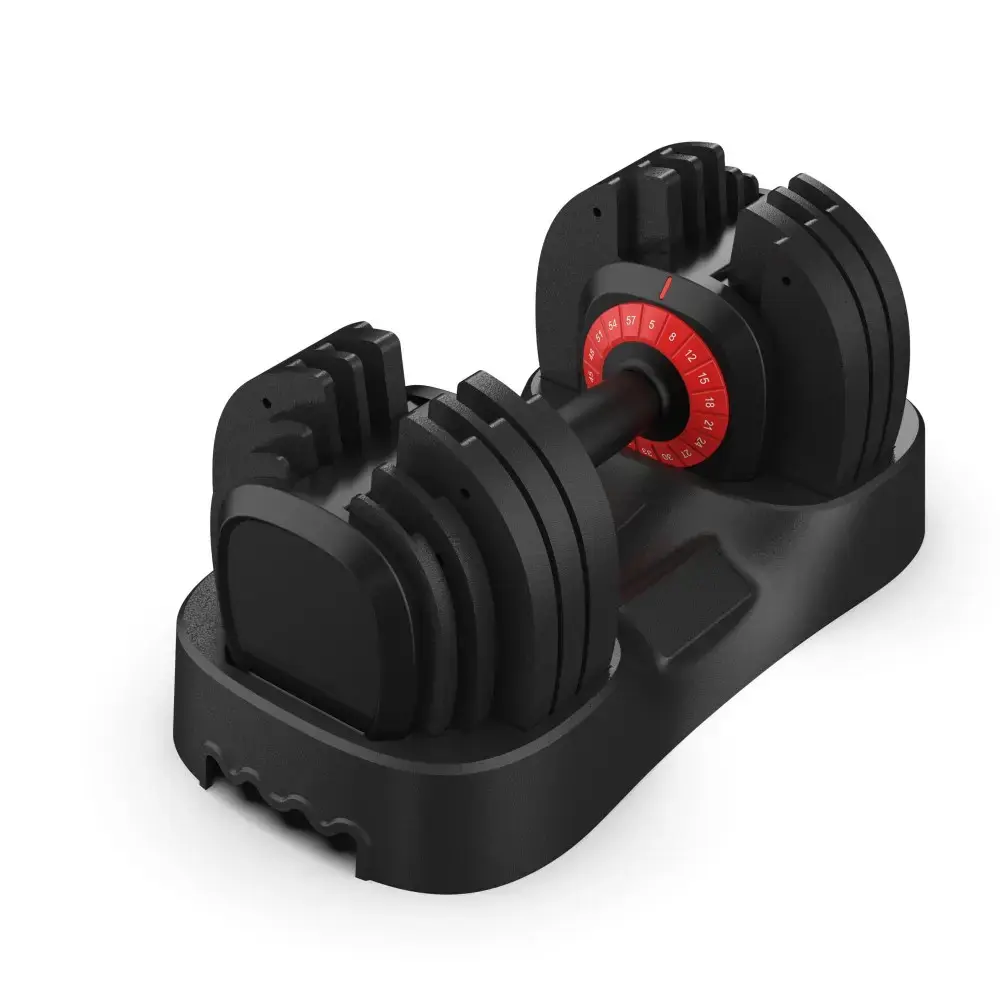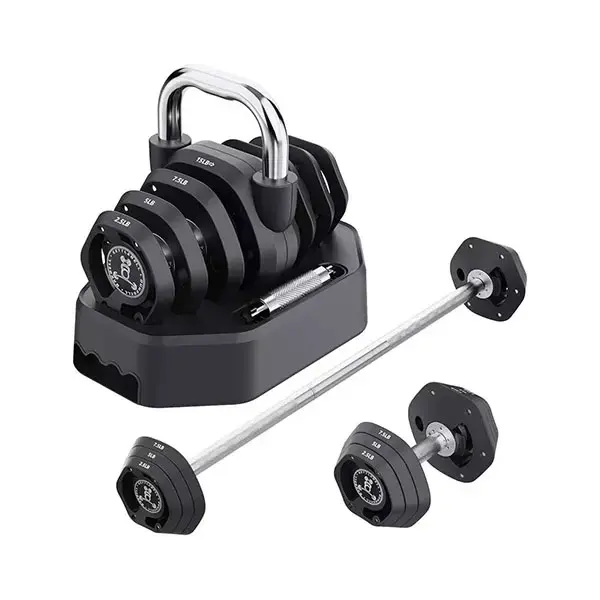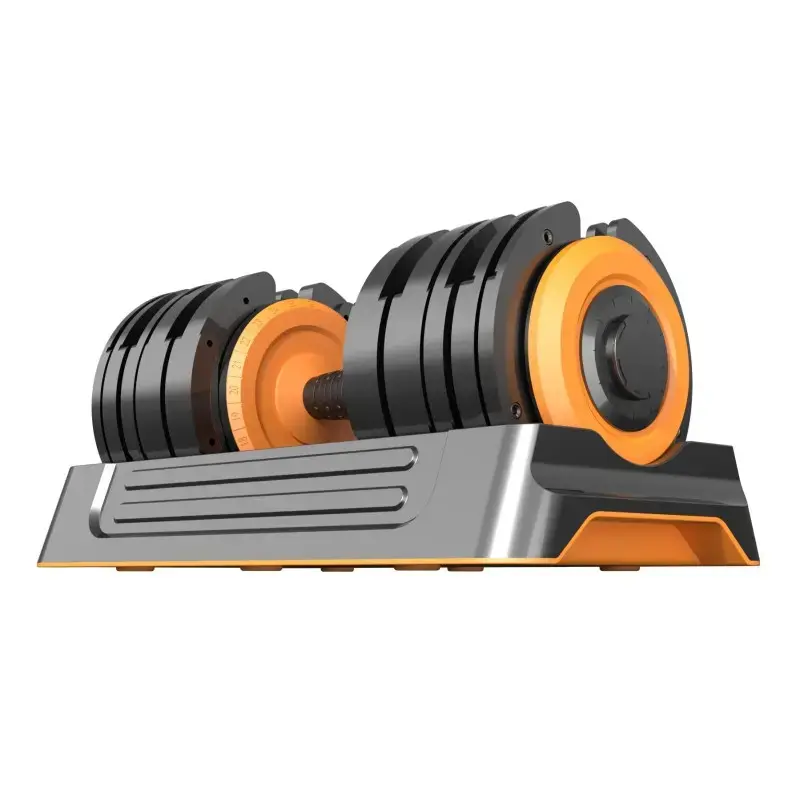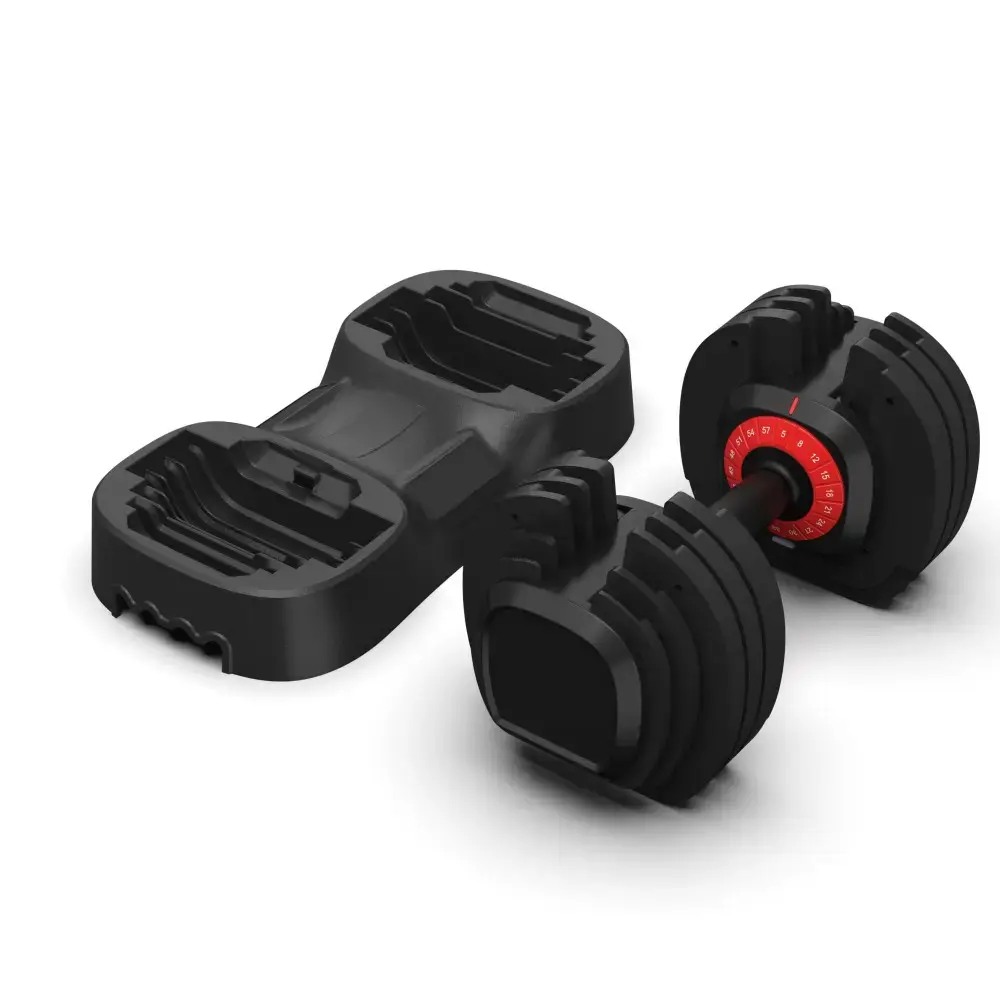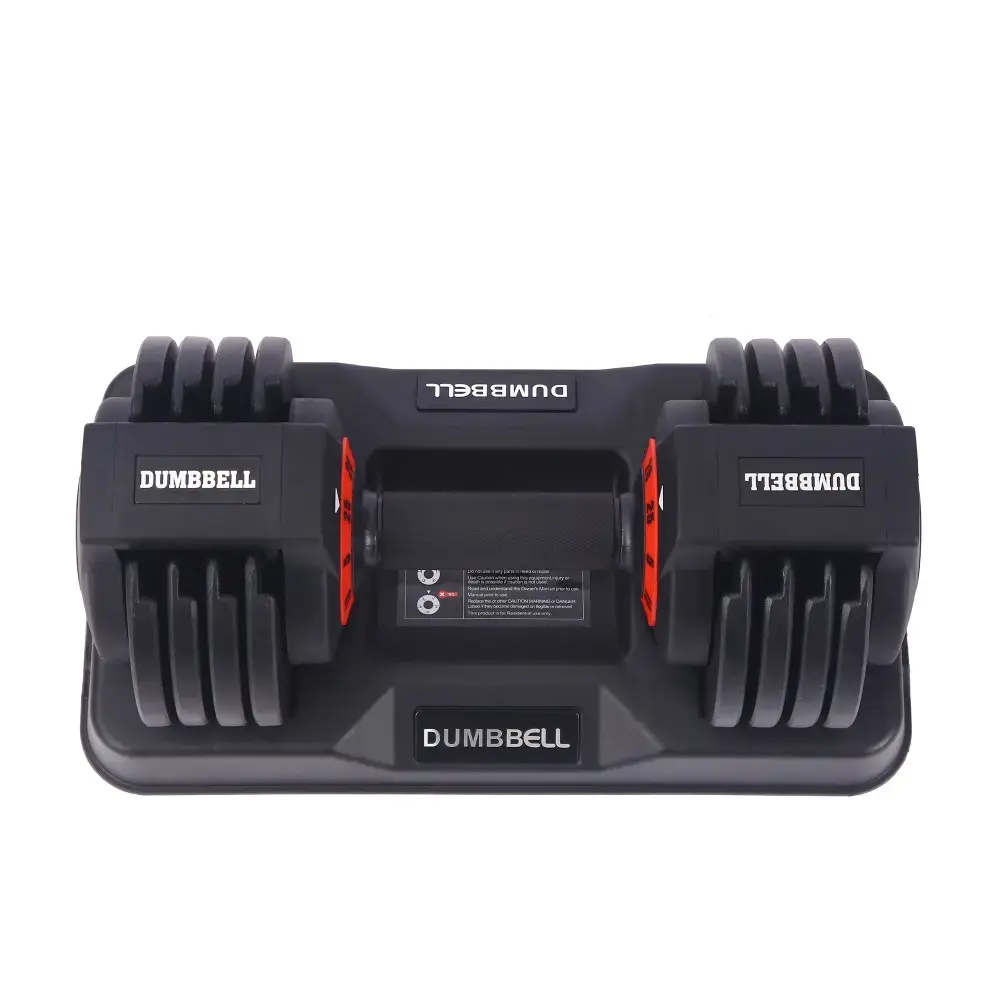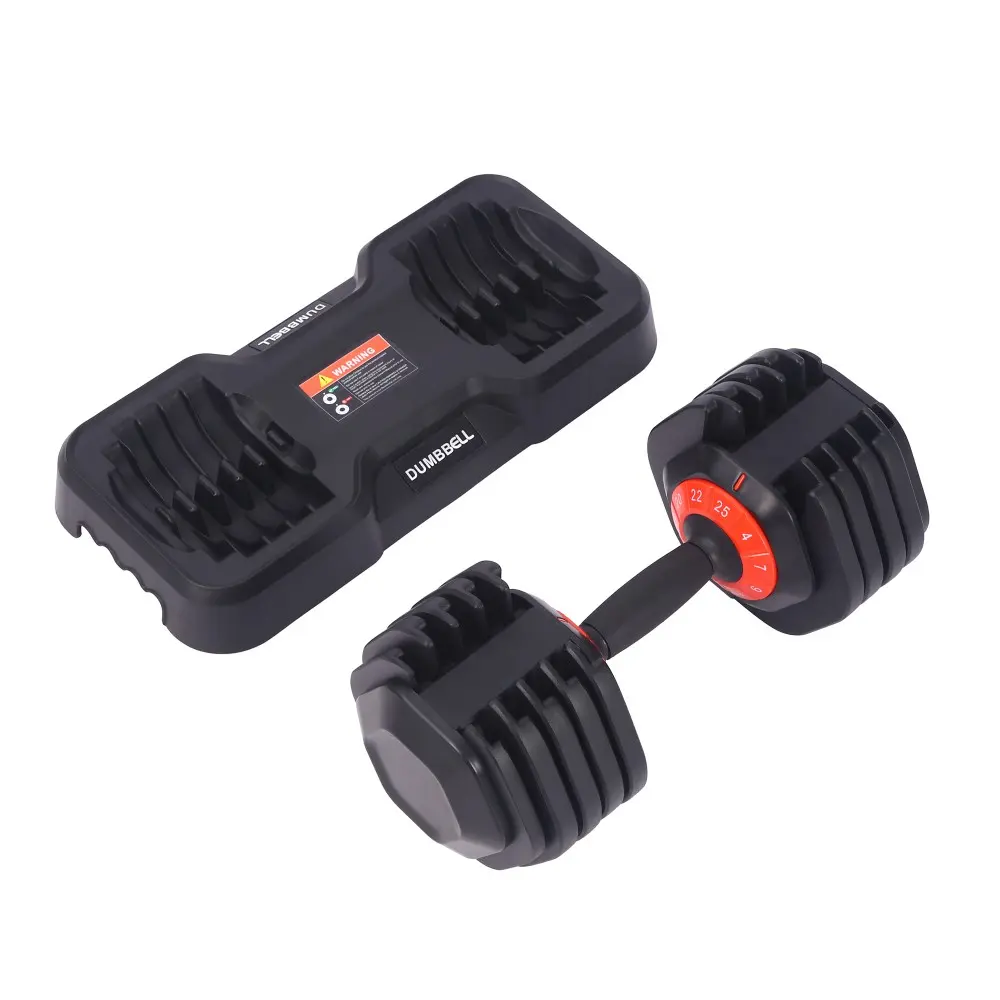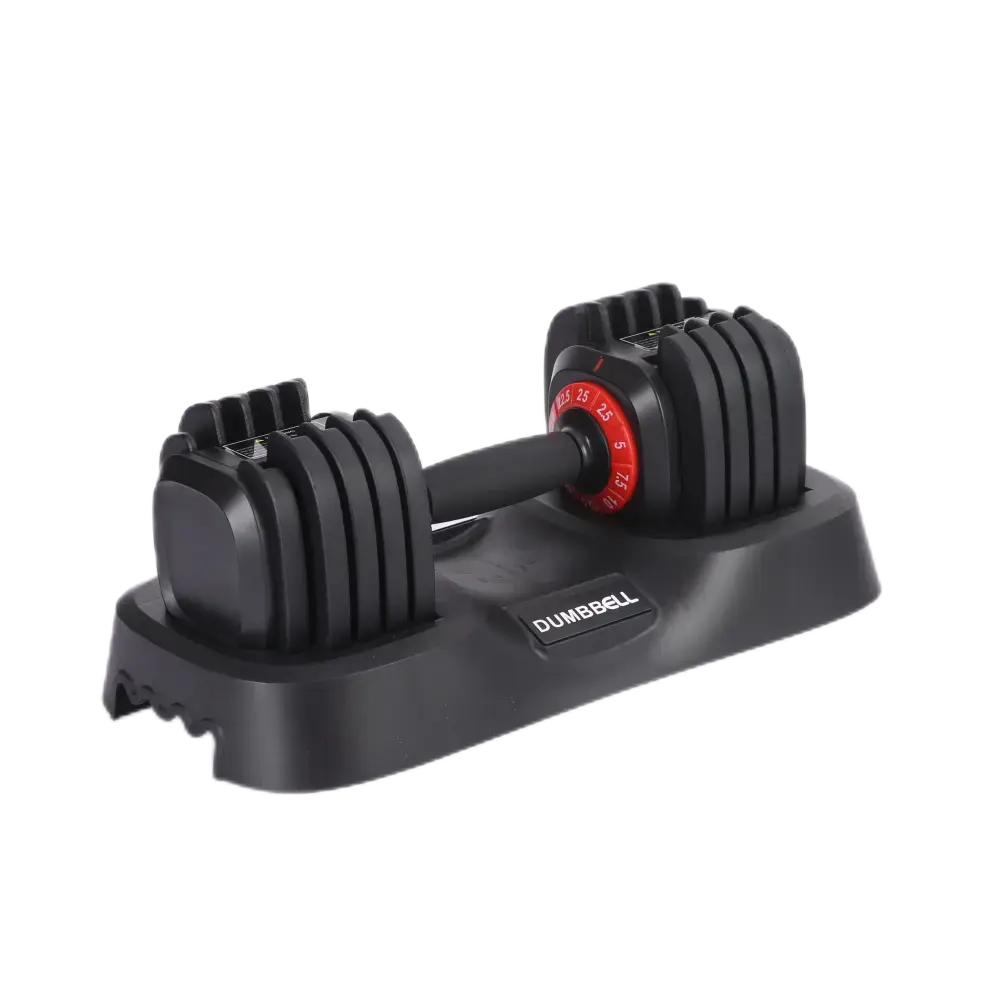Adjustable dumbbells: Maintain consistent overall light perception
Adjustable Dumbbells: Maintain consistent overall light perception
In today's fitness equipment market, adjustable dumbbells have become the focus of many international wholesale buyers due to their convenience, efficiency and versatility. It not only meets the needs of individual fitness enthusiasts for different weight training, but also provides flexible solutions for gyms, rehabilitation centers and other places. Among these many adjustable dumbbell products, maintaining a consistent overall light perception has become an important consideration for product design and quality. This article will explore in depth all aspects of adjustable dumbbells, including its definition, types, advantages, development history, design elements, quality standards, market analysis, procurement strategies and future trend forecasts, aiming to provide international wholesale buyers with comprehensive and in-depth product information and decision-making references, helping them succeed in this dynamic and potential market.
1. Definition and basic principles of adjustable dumbbells
Adjustable dumbbells are a type of fitness equipment that can easily adjust the weight. Through its unique mechanical structure and design, it enables users to change the weight of the dumbbells in a short time to adapt to different training needs. The basic principle is to use mechanical parts such as levers, nuts, and buckles to fix the weight plates of the dumbbells on the handles. When the weight needs to be adjusted, the total weight of the dumbbells can be changed by simply unfixing, adding or removing weight plates, and refixing them.
2. Types of adjustable dumbbells
Knob-type adjustable dumbbells
Knob-type adjustable dumbbells are one of the most common types. It has knobs at both ends of the handle, and the weight plates are locked or released by rotating the knobs. This design is relatively simple to operate, and users can quickly adjust the weight. Its weight adjustment range is usually wide, ranging from a few kilograms to dozens of kilograms, which can meet the training intensity needs of different users. For example, a set of knob-type adjustable dumbbells may contain multiple weight plates of different weights. By combining these weight plates, users can get a variety of different weight settings, which are suitable for a variety of fitness activities such as full-body strength training, muscle shaping, and rehabilitation training.
Barbell plate-type adjustable dumbbells
The design of the barbell plate-type adjustable dumbbell is similar to that of a traditional barbell, but its weight plates can be removed and installed separately. This type of dumbbell usually has a high weight adjustment accuracy, suitable for professional athletes and fitness enthusiasts to perform precise strength training. Its weight plates can be purchased and replaced separately, providing users with greater flexibility and personalized choices. In addition, the weight of barbell plate-type adjustable dumbbells is usually large, which can meet the needs of high-intensity training, such as weightlifting training and strength competition training.
Hydraulic adjustable dumbbells
Hydraulic adjustable dumbbells are a relatively new type of adjustable dumbbells. It uses a hydraulic system to achieve automatic weight adjustment. Through the built-in hydraulic device, users can adjust the resistance of the dumbbells as needed to change the training intensity. The advantage of this dumbbell is that its weight adjustment is smoother and more precise, which can provide a more stable training experience. At the same time, hydraulic adjustable dumbbells usually have a smaller size and weight, which is easy to carry and store, and is suitable for home fitness and personal travel training. However, its relatively high price and the need for regular maintenance of the hydraulic system may limit its popularity in some market segments.
3. Advantages of adjustable dumbbells
Save space and cost
Traditional fixed-weight dumbbells need to be equipped with multiple dumbbells of different weights to meet different training needs, which not only takes up a lot of storage space, but also has a high cost. Adjustable dumbbells can adjust multiple weights on one handle, which greatly saves storage space and reduces purchase costs. Adjustable dumbbells are an ideal choice for home fitness environments and small gyms with limited space. At the same time, for international wholesale buyers, purchasing adjustable dumbbells can reduce product variety and inventory pressure and improve the efficiency of capital use.
Improve training efficiency and flexibility
Adjustable dumbbells allow users to quickly adjust weights without interrupting training, which means that different weights can be used in the same training process to improve training efficiency. For example, when doing a set of muscle exercises, you can start with a lighter weight for warm-up, then gradually increase the weight for strength training, and finally reduce the weight for stretching and recovery. This flexible weight adjustment method enables users to better adapt to different training plans and goals and improve training results. In addition, adjustable dumbbells can also be used for a variety of different training movements and muscle groups, providing users with a comprehensive fitness solution.
Adapt to different user groups
Adjustable dumbbells have a wide range of weights, from light weights suitable for beginners to heavy weights suitable for professional athletes, so they can meet the needs of user groups of different ages, genders, fitness levels and training goals. Whether it is basic strength training for fitness novices, high-intensity strength and explosiveness training for athletes, or gentle muscle recovery training for rehabilitation patients, adjustable dumbbells can provide suitable weight settings and have strong versatility and adaptability. For international wholesale buyers, this means that the product has a wider market audience and sales potential.
IV. The development history of adjustable dumbbells
Early stage
The concept of adjustable dumbbells can be traced back to the early 20th century, when some fitness enthusiasts and equipment manufacturers began to try to design dumbbells that can change weight. These early adjustable dumbbells had relatively simple structures, usually using basic mechanical parts such as nuts and bolts to fix the weight plates. However, due to technical and process limitations, these products had a small weight adjustment range, were not convenient to operate, and had room for improvement in weight stability and reliability.
Mid-term development
In the mid-20th century, with the gradual popularization of fitness and technological advances, adjustable dumbbells were further developed. Some innovative designs were introduced, such as knob-type locking mechanisms and more efficient weight plate fixing systems, making weight adjustment more convenient and reliable. At the same time, the development of material science also provided better options for the manufacture of adjustable dumbbells, such as the application of high-strength steel and durable plastic materials, which improved the quality and durability of the products. Adjustable dumbbells during this period began to gain more attention and application in the market, and gradually became an important part of the field of fitness equipment.
Modern Innovation
Entering the 21st century, the rapid development of science and technology has brought more innovations to adjustable dumbbells. For example, the application of electronically controlled weight adjustment systems, smart sensors and connection functions makes adjustable dumbbells more intelligent and personalized. Some high-end adjustable dumbbells can be connected to mobile phone applications, through which users can set training plans, record training data, and adjust weights according to real-time feedback. In addition, the application of new materials and manufacturing processes, such as carbon fiber composite materials and 3D printing technology, makes adjustable dumbbells more lightweight, high-strength and high-precision. These innovations not only improve the performance and user experience of the products, but also expand the application areas and market prospects of adjustable dumbbells.
5. Design elements of adjustable dumbbells
Appearance design
The appearance design of adjustable dumbbells is crucial to the overall light and attractiveness of the product. A good appearance design can not only enhance the beauty of the product, but also increase the user's favorability and willingness to buy. In terms of appearance design, the following factors need to be considered:
Shape and size: The shape and size of the handle should conform to the principles of ergonomics to ensure that the user can get a comfortable and stable grip when holding it. At the same time, the overall shape of the dumbbell should be simple and smooth, avoiding sharp corners and complex structures to reduce visual discomfort and potential safety risks.
Color matching: Color has an important impact on the visual effect of the product. The color of the adjustable dumbbell should be selected to match the fitness environment and brand image, such as classic black, silver, gray and other metallic tones, which can convey a sense of professionalism, high-end and durability. In addition, some bright colors or colorful elements can be appropriately added as embellishments to increase the vitality and attractiveness of the product, but care should be taken to avoid overly fancy color combinations so as not to affect the overall light and professionalism of the product.
Surface treatment: Surface treatment techniques such as painting, electroplating, and brushing can affect the appearance texture and glossiness of dumbbells. High-quality surface treatment can make dumbbells have a smooth and uniform surface, reflecting soft and consistent light, thereby enhancing the overall light perception. For example, dumbbells with high-gloss mirror electroplating will present a bright and exquisite appearance, while matte painting can create a low-key and calm style. According to the product positioning and target customer groups, choose the appropriate surface treatment process to achieve the ideal appearance effect.
Mechanical structure design
Mechanical structure design is the core part of adjustable dumbbells, which is directly related to the functionality and reliability of the product. A reasonable and efficient mechanical structure design can ensure the convenience, stability and safety of weight adjustment. In terms of mechanical structure design, the following points need to be paid attention to:
Locking mechanism: The locking mechanism is a key component to ensure that the weight plate does not loosen or fall off during training. Common locking mechanisms include knob type, buckle type, nut type, etc. When designing, it should be ensured that the locking mechanism has sufficient strength and stability to maintain reliable locking when subjected to large weight and impact force. At the same time, the locking and unlocking operations should be simple and convenient, and users can easily adjust the weight without complicated tools or excessive physical strength. For example, some advanced locking mechanisms adopt a self-locking design, which will automatically lock when the weight plate is installed in place, and can be unlocked with a light press or rotation, which greatly improves the convenience of use.
Weight plate fixing method: The weight plate fixing method should ensure that the weight plate will not be displaced or shaken during training, so as to avoid affecting the training effect and safety. Commonly used methods include insertion, threaded, and slotted. The insertion fixing method inserts the weight plate into a specific position of the handle and fixes it with a locking device, which has the characteristics of simple structure and convenient installation; the threaded fixing method uses a threaded connection to tightly fix the weight plate on the handle, which can provide higher stability; the slotted fixing method sets a slot on the handle and the weight plate, so that the weight plate is fixed after being inserted into the slot, which has the advantage of quick installation and removal. According to the design requirements of the product and user needs, choose the appropriate weight plate fixing method to achieve the best fixing effect.
Weight adjustment range and accuracy: The weight adjustment range determines the training intensity that the adjustable dumbbell can meet and the breadth of the user group. Generally speaking, the larger the weight adjustment range, the stronger the applicability of the product. However, it is also necessary to consider the size and weight limits of the product to ensure a larger weight adjustment range within a reasonable range. At the same time, the weight adjustment accuracy is also very important, which affects the user's accurate control of the training weight. High-precision weight adjustment can meet the needs of professional athletes and fitness enthusiasts for precise training and improve the training effect. For example, some high-end adjustable dumbbells can be accurate to 0.5 kg or even smaller weight adjustment units, allowing users to make more detailed training adjustments.
Material selection
Material selection plays a decisive role in the performance, quality and safety of adjustable dumbbells. Choosing the right material can ensure the durability, strength, stability and comfort of the product. The following are the key points of material selection for the main components of adjustable dumbbells:
Handle material: The handle is usually made of high-strength steel, such as alloy steel, stainless steel, etc. These materials have good tensile strength, wear resistance and corrosion resistance, and can withstand large weights and repeated use. At the same time, the surface of the steel can be treated in various ways, such as painting, electroplating, sandblasting, etc., to improve the feel and appearance. Some high-end products may also use lightweight and high-strength materials such as titanium alloy to reduce the weight of the handle and improve the user experience, but the cost is relatively high.
Weight plate material: The materials of the weight plate are mainly cast iron, rubber, hard plastic, etc. Cast iron weight plates have high density and strength, can provide stable weight and good training effect, but are relatively heavy and have high surface hardness, which may cause certain wear and tear on the ground and equipment; rubber weight plates have good elasticity and shock absorption performance, can reduce noise and damage to the ground, and can also provide certain anti-slip effects, but their density and strength are relatively low, and the weight accuracy may be slightly worse; hard plastic weight plates are light in weight, low in cost, and have certain wear resistance and corrosion resistance, but their strength and stability are not as good as cast iron and rubber weight plates. In actual applications, you can choose the appropriate weight plate material according to the product positioning and user needs, or use a combination of materials to take into account different performance characteristics.
Other component materials: In addition to handles and weight plates, adjustable dumbbells also contain some other components, such as knobs, buckles, nuts, bolts, hydraulic components, etc. The material selection of these components should also meet the corresponding performance requirements. For example, knobs and buckles are usually made of plastic or metal. Plastic knobs are light, low cost, and comfortable to the touch, but their strength and durability are relatively low; metal knobs are more durable, but heavier. Hydraulic components need to use corrosion-resistant, wear-resistant, and well-sealed materials to ensure the normal operation and reliability of the hydraulic system.
VI. Quality standards and testing methods for adjustable dumbbells
Quality standards
Weight accuracy: The weight accuracy of adjustable dumbbells is one of the important indicators for measuring product quality. Generally speaking, the higher the weight accuracy, the better the product quality. The standards commonly used internationally include national standards, industry standards, and corporate standards. For example, in some European and American countries, the weight accuracy requirements for fitness equipment are high, and the weight error is usually required to be within ±1%. In order to meet this standard, manufacturers need to use high-precision production equipment and strict production process control to ensure that the weight of the weight plate and the dimensional accuracy of the handle meet the requirements.
Strength and durability: Adjustable dumbbells need to withstand large weights and impact forces during frequent use, so their strength and durability are essential. The quality standard should specify the weight range and number of uses that the product can withstand under normal use conditions, and that the product's performance should not be significantly reduced or damaged after a certain number of weight adjustments and training. For example, the product should be able to withstand more than 10,000 weight adjustment cycle tests, and indicators such as the deformation of the handle and weight plate, and the degree of wear of the locking device should be within the allowable range.
Safety: Safety is the core content of the quality standard of adjustable dumbbells. Products should comply with relevant safety regulations and standards to ensure that they will not cause harm to users during use. This includes the safety and reliability of the locking device to prevent the weight plate from loosening or falling off during training; the surface of the handle should be free of sharp edges and burrs to avoid scratching the user; the fixing method of the weight plate should be firm and reliable to prevent displacement or shaking during use; in addition, the product should have sufficient stability and will not easily tip over or slide during placement and use to ensure the safety of users.
Environmental protection: With the improvement of environmental awareness, the environmental protection of adjustable dumbbells has also become an important part of the quality standard. The materials of the product should meet environmental protection requirements and do not contain substances that are harmful to the human body, such as heavy metals such as lead, cadmium, mercury, and harmful chemicals such as phthalates. At the same time, the pollution to the environment should be minimized during the production process, and environmentally friendly production processes and materials should be adopted.
Testing method
Weight detection: Use a high-precision electronic scale or balance to perform weight detection on the adjustable dumbbell. Before testing, the equipment should be calibrated to ensure the accuracy of the measurement results. Place the assembled dumbbell on the scale plate, record its total weight, and then check the accuracy and stability of the weight adjustment by adding or removing weight pieces and retesting. At the same time, weigh each weight piece separately to check whether its weight deviation is within the allowable range.
Strength detection: Adjustable dumbbells can be tested for strength using a material testing machine or a special fitness equipment strength testing device. Fix the dumbbell on the test equipment and apply gradually increasing weight or load until the maximum load specified for the product is reached or damage occurs. Record the product's deformation, breaking load and other data to evaluate whether its strength meets the quality standard requirements. In addition, fatigue tests can be performed to simulate the repeated loading and unloading of the product during actual use. After a certain number of cycles, check whether the product has fatigue damage or performance degradation.
Safety testing: Safety testing mainly includes reliability testing of the locking device, surface treatment of the handle, and structural safety inspection. For the locking device, multiple locking and unlocking operation tests can be performed manually or automatically to check whether it can be locked and unlocked smoothly, and whether it will loosen or fail when subjected to a certain tensile force or impact force. At the same time, the strength of the locking device is tested to ensure that it can withstand sufficient load without being damaged.
VII. Market Analysis of Adjustable Dumbbells
Global Market Overview
The adjustable dumbbell market is showing a continuous growth trend worldwide. With the improvement of people's health awareness and the popularization of fitness culture, more and more people are participating in fitness activities, and the demand for fitness equipment is also increasing. As an efficient and convenient fitness equipment, adjustable dumbbells have been widely welcomed by the market. According to reports from market research institutions, the global adjustable dumbbell market is expected to grow at an annual compound growth rate of [X]% in the next few years, and the market size will reach [X] billion US dollars. Among them, North America, Europe and Asia-Pacific are the main market regions, each occupying a large market share.
Regional market characteristics
North American market: North America is one of the main consumer markets for adjustable dumbbells, and countries such as the United States and Canada have a high demand for fitness equipment. Consumers in this region pay attention to the quality, function and design of products, and have a high acceptance and purchasing power for high-end, intelligent adjustable dumbbell products. In addition, the fitness industry in North America is relatively developed, with a large number of gyms and fitness clubs, and there is a large demand for bulk purchases of adjustable dumbbells. At the same time, e-commerce platforms are also very developed in North America, and many consumers purchase adjustable dumbbells through online shopping websites, which provides a good sales channel for international wholesale buyers.
European market: The demand for adjustable dumbbells in the European market is also growing, and consumers have high requirements for product safety, environmental protection and ergonomic design. The fitness culture of European countries varies. For example, consumers in countries such as Germany and the United Kingdom pay more attention to the quality and performance of products, while consumers in countries such as France and Italy pay more attention to the appearance design and fashion elements of products. In terms of sales channels, in addition to traditional sporting goods stores and fitness equipment stores, some large supermarkets and department stores have also begun to sell adjustable dumbbells, providing wholesale buyers with diversified sales channel options.
Asia-Pacific market: The Asia-Pacific region is one of the fastest growing regions in the adjustable dumbbell market. With the rapid development of China's economy and the improvement of residents' income levels, Chinese consumers' demand for fitness equipment has shown explosive growth. At the same time, the fitness markets in countries such as India, Japan, and South Korea are also gradually emerging, providing a broad space for the development of the adjustable dumbbell market. Consumers in the Asia-Pacific region have high requirements for the cost-effectiveness of products and have a large demand for adjustable dumbbell products at mid- and low-end prices. In addition, the Asia-Pacific region has many fitness equipment manufacturers and is an important production base for adjustable dumbbells in the world, which gives international wholesale buyers more choices and competitive advantages in the procurement process.
Competitive landscape
The adjustable dumbbell market is highly competitive, and the main competitors include internationally renowned brands, regional brands, and emerging brands. Internationally renowned brands such as [Brand Name 1], [Brand Name 2], etc., have occupied a high market share in the global market with their strong brand influence, advanced technology, and high-quality product quality. These brands usually focus on product research and development and innovation, and continuously launch adjustable dumbbell products with high-tech content and personalized design to meet the needs of the high-end market. Regional brands have certain advantages in the local market. They can better understand the needs of local consumers and market characteristics and provide targeted products and services. Emerging brands have quickly emerged and occupied a place in the market with innovative design concepts, flexible marketing strategies and competitive prices. These emerging brands usually focus on a specific field or market segment and attract consumers through differentiated competition.
8. Strategies and suggestions for international wholesale procurement of adjustable dumbbells
Supplier selection
Supplier qualifications and reputation: When choosing an adjustable dumbbell supplier, the first thing to do is to examine the supplier's qualifications and reputation. Check whether the supplier has legal production and operation qualifications, such as business licenses, production licenses, quality management system certifications and other certificates, as well as its reputation and credibility in the industry. You can understand the supplier's comprehensive strength and reputation by consulting relevant industry reports, customer reviews, supplier credit ratings, etc., and choose suppliers with good reputation and complete qualifications to cooperate to reduce procurement risks.
Production capacity and quality control: The supplier's production capacity directly affects whether it can meet procurement needs on time, in quality and in quantity. Investigate the supplier's production equipment, process flow, production workshop scale and employee quality, and evaluate its production capacity and technical level. At the same time, understand the supplier's quality control system, including raw material procurement inspection, production process quality monitoring, finished product inspection and other links, to ensure that the supplier can produce adjustable dumbbell products that meet quality standards. In addition, the supplier's quality certification (such as ISO 9001 quality management system certification, CE certification, GS certification, etc.) is also an important basis for measuring its quality control capabilities.
Product innovation capability: With the continuous development of the market and the changes in consumer demand, the product innovation capability and R&D strength of adjustable dumbbells have also become important factors in selecting suppliers. Suppliers with strong product innovation capabilities can continuously launch new models, new functions, and new designs of adjustable dumbbell products to meet the differentiated needs of the market for products and improve the competitiveness of products. Understand the supplier's R&D investment, R&D team size, patented technology, etc., evaluate its product innovation capabilities, and select suppliers that can develop in sync with market demand to provide guarantees for the long-term development of wholesale procurement business.
Procurement cost control
Price negotiation strategy: Procurement cost is one of the core issues of concern to international wholesale buyers. When negotiating prices with suppliers, scientific and reasonable negotiation strategies should be adopted. First of all, the market price of adjustable dumbbells should be fully investigated to understand the price range of products of different brands, specifications, and quality grades, as well as the market price fluctuation trend. Then, according to its own procurement scale, procurement frequency, payment method and other factors, formulate a reasonable procurement budget and target price. In the negotiation process, it is necessary to give full play to the scale advantage and market information advantage of the purchaser, fully communicate and negotiate with the supplier, and strive to obtain the best price discounts and preferential policies. For example, bulk purchase discounts, long-term cooperation discounts, seasonal promotions, etc. can be used to reduce procurement costs.
Cost analysis and optimization: In addition to price negotiations, buyers should also conduct detailed procurement cost analysis, including product costs, transportation costs, tariffs, warehousing costs, marketing costs and other aspects. Through cost analysis, find out the key factors and optimizable links in the cost structure, and take corresponding measures to control and optimize costs. For example, optimize the procurement route, select the most suitable transportation method and logistics supplier to reduce transportation costs; plan inventory reasonably, and adopt advanced inventory management methods such as economic order quantity model (EOQ) and just-in-time procurement (JIT) to reduce inventory backlogs and warehousing costs; in addition, you can also establish a strategic partnership with suppliers to jointly optimize product design and production processes and reduce product costs.
Contract terms and risk management
Contract terms formulation: When signing a procurement contract with a supplier, the contract terms should be carefully formulated to clarify the rights and obligations of both parties. The contract terms should include product quality standards, delivery time, delivery location, price, payment method, packaging requirements, after-sales service, breach of contract liability and other contents. Special requirements for adjustable dumbbell products should be detailed in the contract, such as weight accuracy, strength standards, safety certification, etc., to ensure that suppliers provide qualified products in accordance with the contract requirements. At the same time, the contract should clearly stipulate the supplier's breach of contract liability and compensation methods, such as liquidated damages payment, product replacement or return in the case of delayed delivery, unqualified product quality, etc., to protect the legitimate rights and interests of buyers.
Risk management measures: In the process of international wholesale procurement, there are various risks, such as market risk, credit risk, transportation risk, exchange rate risk, etc. In order to reduce the impact of these risks on procurement business, buyers should take effective risk management measures. For example, conduct in-depth analysis and forecasting of the market, and adjust procurement plans and product strategies in time to cope with the risks brought by market fluctuations and changes in demand; evaluate and monitor the credit of suppliers, select suppliers with good credit, and adopt appropriate credit insurance or guarantee measures to reduce credit risks; during transportation, choose reliable logistics partners, purchase transportation insurance, strengthen the tracking and monitoring of goods, and ensure that the goods arrive safely at the destination; in addition, financial instruments such as hedging can be used to manage exchange rate risks and reduce the impact of exchange rate fluctuations on procurement costs.
After-sales service and customer relationship management
After-sales service support: Good after-sales service is an important factor in improving customer satisfaction and loyalty. When purchasing adjustable dumbbells, suppliers should be required to provide comprehensive after-sales service support, including product warranty, repair, return and exchange policies, etc. Understand the supplier's after-sales service network and service response time to ensure that when product quality problems occur or customers need technical support, they can be resolved in a timely manner. At the same time, buyers can also establish their own after-sales service team or cooperate with local after-sales service agencies to provide customers with better after-sales service and enhance market competitiveness.
Customer relationship management: International wholesale buyers should attach importance to long-term cooperative relationships with customers and improve customer satisfaction and loyalty through effective customer relationship management strategies. Establish a complete customer information management system to record customer basic information, purchase history, preference needs and other data in order to better understand customer needs and provide personalized services and product recommendations. Communicate and provide feedback with customers regularly to understand their opinions and suggestions on products and services, and solve problems and improve deficiencies in a timely manner. In addition, you can also strengthen interaction and cooperation with customers and consolidate customer relationships by holding customer events, providing training and technical support, etc.
IX. Future development trend of adjustable dumbbells
Intelligence and interconnection
With the continuous development of technologies such as the Internet of Things, big data, and artificial intelligence, adjustable dumbbells will also develop in the direction of intelligence and interconnection. Future adjustable dumbbells may be equipped with more intelligent sensors and connection functions, such as heart rate monitoring, motion trajectory tracking, training data analysis, etc., and transmit and interact with mobile devices such as smartphones and tablets in real time. Users can remotely control and adjust the weight of the dumbbells through mobile phone applications, while obtaining personalized training plans and real-time feedback to improve training effects and experience. In addition, Smart Adjustable Dumbbells can also be integrated with other fitness equipment and applications to achieve all-round fitness management and social interaction, providing users with more intelligent, convenient and personalized fitness solutions.
Green environmental protection and sustainable development
Against the background of increasing environmental awareness, green environmental protection and sustainable development will become an important development trend of the adjustable dumbbell industry. Future adjustable dumbbells will pay more attention to the selection of materials and the environmental protection of production processes, and use recyclable, renewable, non-toxic and harmless materials to manufacture products to reduce pollution to the environment and resource consumption. At the same time, production companies will adopt more energy-saving and efficient production processes to reduce energy consumption and waste emissions during the production process. In addition, product design will also pay more attention to service life and maintainability, improve product durability and reliability, extend product service life, and reduce the frequency of product replacement, so as to achieve sustainable development goals.
Personalized customization and diversified design
Consumers' personalized needs for fitness equipment and differences in aesthetic concepts will drive the adjustable dumbbell market towards personalized customization and diversified design. In the future, adjustable dumbbells will provide more customized options, such as the color, material, shape of the handle, the appearance design of the weight plate, and the weight combination, etc., to meet the personalized needs of different consumers. At the same time, product design will pay more attention to the integration of fashion elements and innovative concepts, and launch adjustable dumbbell products with unique styles and functions, such as foldable dumbbells, travel Portable Dumbbells, children's special dumbbells, etc., to meet the needs of different usage scenarios and consumer groups.
High performance and specialization
In order to meet the strict requirements of high-end user groups such as professional athletes and fitness coaches for adjustable dumbbells, adjustable dumbbells will continue to innovate and improve in high performance and specialization in the future. This includes providing more precise weight adjustment accuracy, higher weight bearing capacity, more stable weight fixing performance, better ergonomic design, etc. For example, develop adjustable dumbbells with a weight adjustment accuracy of 0.1 kg or even less to meet the needs of professional strength training and fine muscle shaping; develop high-strength, lightweight new materials to reduce the weight of dumbbells while improving their strength and durability; optimize the mechanical structure and handle design of dumbbells to improve the comfort and safety of training. In addition, professional adjustable dumbbells will also be equipped with a more complete training guidance and certification system to provide users with more professional technical support and services.
In summary, as a fitness equipment with broad market prospects and huge development potential, adjustable dumbbells are constantly meeting people's growing fitness needs while also facing challenges in technology and market competition. For international wholesale buyers, in-depth understanding of the product characteristics, advantages, quality standards, market dynamics and future development trends of adjustable dumbbells, formulating scientific and reasonable procurement strategies and decisions, selecting high-quality suppliers and products, and providing good after-sales service and customer relationship management will help to stand out in the fierce market competition and achieve sustainable development and success. In the future fitness equipment market, adjustable dumbbells will continue to play an important role, and with the innovation of technology and the expansion of the market, they will inject new vitality and impetus into the development of the global fitness industry.


